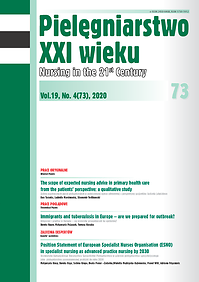ICNP® – why not? Nurses’ opinions on the implementation of ICNP® vocabulary for clinical practice
DOI:
https://doi.org/10.2478/pielxxiw-2020-0034Keywords:
classification, ICNP®, nursing electronic recordsAbstract
ICNP® – WHY NOT? NURSES’ OPINIONS ON THE IMPLEMENTATION OF ICNP® VOCABULARY FOR CLINICAL PRACTICE
Introduction. The most important application of information technology in nursing is generating and maintaining patient’s electronic records. Implementing ICNPR to this can guarantee the continuity and high quality of evidence-based care.
Aim. Obtaining information on nurses’ opinions on the implementation of ICNPR in clinical practice.
Material and methods. The study was conducted in late 2018 and early 2019 in a group of 104 nurses of the University Clinical Centre in Gdańsk. It involved conducting a diagnostic survey.
Results. Prior to the survey, 77.9% of the respondents were aware of ICNPR. The respondents who did not provide the correct answer to question about the essence of the ICNPR were mostly over 45 years of age. When it comes to 25% of subjects, they declared they were willing to use ICNPR. The vast majority considered it more convenient to maintain care records in the traditional way than with the use of ICNPR. The respondents with a master’s degree showed a higher level of acceptance for the implementation of the ICNPR to clinical practice than respondents with secondary and tertiary education.
Conclusions. The nursing staff over 45 years old presented a lower level of knowledge related to the ICNPR as compared to other respondents. The reasons behind the conviction that applying ICNPR would be difficult included understaffing and lack of mobile devices such as tablets or laptops in hospital wards. It is, therefore, necessary to launch a nursing terminology training programme, equip branches with the necessary devices and comply with minimum employment standards.
References
1. Kilańska D. Informatyka w pielęgniarstwie [w:] Kilańska D, Grabowska H, Gaworska- Krzemińska A. E-zdrowie. Wprowadzenie do informatyki w pielęgniarstwie. Warszawa: Wydawnictwo Lekarskie PZWL; 2018, s.13-28: 70-86.
2. Kilańska D. Elektroniczny rekord pacjenta w opinii pielęgniarek. Implikacje do dydaktyki – wykorzystanie narzędzi IT w nauczaniu klasyfikacji ICNP® Probl. Pielęg. 2017; 25 (2): 69-76.
3. Fernandes Beserr PJ, Lima Gomes GL, de Figueiredo Sant MC, et.al. Scientific production of the International Classification for Nursing Practice: a bibliometric study. Rev. Bras. Enferm. 2018; 71 (6): 3032-3041.
4. Bartz C, Coenen A. ICNP®: Nursing terminology to improve healthcare worldwide. [w:] Carr R. Delaney C. Weaver C, et.al. Nursing and Informatics for the 21st Century: An International Look at Practice, Education and EHR Trends, Second Edition. CRC Press, 2016. s: 207-211.
5. Ustawa z dnia 28 kwietnia 2011 o systemie informacji w ochronie zdrowia (tekst jednolity Dz.U. 2011 nr 113 poz. 657) http://prawo.sejm.gov.pl/isap.nsf/download. xsp/WDU20190000408/U/D20190408Lj [dostęp: 25.04.2020]
6. Centrum Systemów Informacyjnych Ochrony Zdrowia. Badanie stopnia informatyzacji podmiotów wykonujących działalność leczniczą. Warszawa 2018. https://www.csioz.gov.pl/fileadmin/user_upload/Biuletyny_informacyjny/ badanie_ankietowe_nt_poziomu_informatyzacji_2018_5bbcd177bc7dd.pdf [dostęp: 20.04.2020]
7. Polityka wieloletnia państwa na rzecz pielęgniarstwa i położnictwa w Polsce (z uwzględnieniem etapów prac zainicjowanych w roku 2018) https://www. gov.pl/web/zdrowie/polityka-wieloletnia-panstwa-na-rzecz-pielegniarstwa-i-poloznictwa-w-polsce [dostęp: 22.04.2020]
8. Szczegółowy opis przedmiotu zamówienia - przeprowadzenie pilotażu standaryzacji opieki pielęgniarskiej w podmiotach leczniczych w ramach projektu „Rozwój kompetencji pielęgniarskich” http://www.zzpprzymz.pl/pliki/2017/09/ ZZP-127_17_zal_siwz005.pdf [dostęp: 22.04.2020]
9. Grabowska H. Zakres wykorzystania ICNP® w nauczaniu podstaw pielęgniarstwa w uczelniach polskich. Doniesienie wstępne. Probl. Pielęg. 2017; 25 (2): 77-81.
10. Kilańska D. Elektroniczny rekord pacjenta w opinii pielęgniarek. Implikacje do dydaktyki – wykorzystanie narzędzi IT w nauczaniu klasyfikacji ICNP® Probl. Pielęg. 2017; 25 (2): 69-76.
11. Foryś Z, Kilańska D, Gorzkowicz B, i wsp. Wiedza i akceptacja pielęgniarek dotycząca wykorzystania i prowadzenia dokumentacji medycznej opartej na wytycznych Międzynarodowej Rady Pielęgniarek – Międzynarodowej Klasyfikacji Praktyki Pielęgniarskiej ICNP® Probl. Pielęg. 2018; 25 (4): 227-232.
12. Di Mauro S, Vanalli M, Alberio M, Ausili D. Developing a subset of ICNP® nursing diagnoses for medical and surgical hospital settings, informed by an Italian nursing conceptual model: a multicenter cross-sectional study; Ann Ig. 2018; 1 (30): 21-33.
13. Sousa P, Balias M. Impact of computerized information system in the global nursing workload: nurses’ perception. BMC Health Serv. Res. 2018; 18 (2): 684.
14. Kilańska D, Gaworska-Krzeminska A, Grabowska H, I wsp. A case study of the introduction of the ICNP® in Poland. Int. Nurs. Rev. 2016; 63(3): 361-371.
Downloads
Published
Issue
Section
License
Copyright (c) 2020 Authors

This work is licensed under a Creative Commons Attribution-NonCommercial-NoDerivatives 3.0 Unported License.




